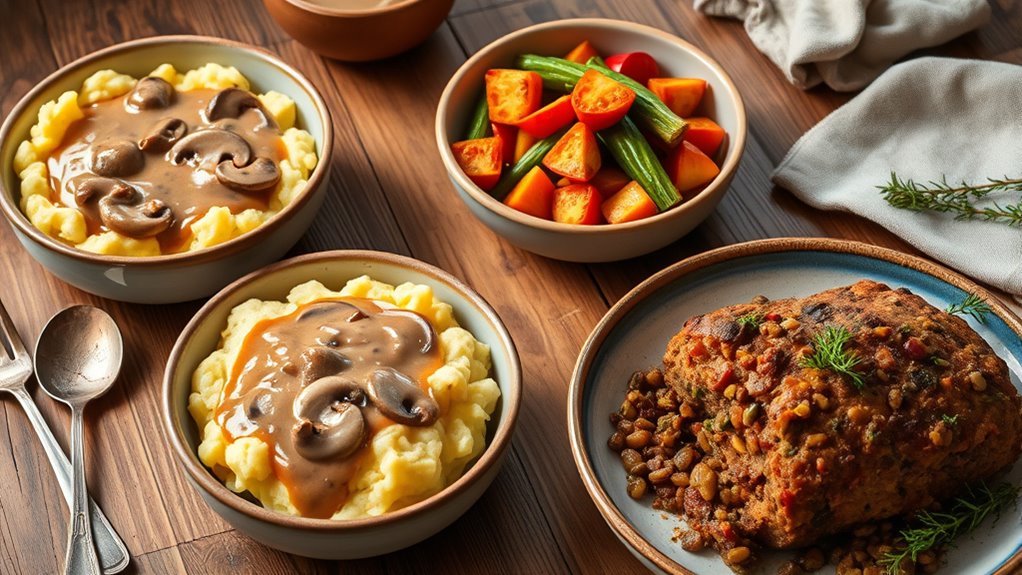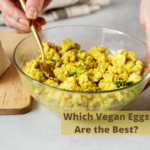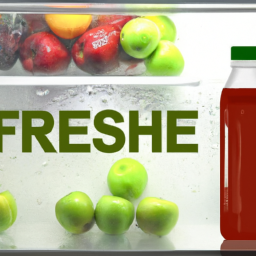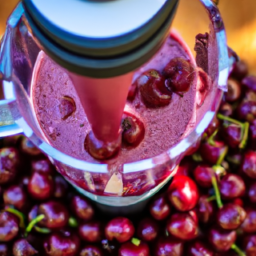To make traditional comfort foods vegan, start by swapping dairy with plant-based options like almond or coconut milk and using flaxseed or chia as egg replacers. Add flavorful herbs and spices to boost taste, and replace meat with legumes, tofu, or seitan for satisfying texture. Master vegan sauces and gravies by thickening with cornstarch or nutritional yeast, and focus on achieving creamy, rich textures with options like cashew or coconut cream. Keep exploring these tips for delicious results.
Key Takeaways
- Substitute dairy with plant-based milks, creams, and cheeses to replicate creamy textures and flavors.
- Replace eggs with flaxseed, chia seeds, or commercial egg replacers to bind ingredients effectively.
- Use vegetables, legumes, and plant proteins like tofu or tempeh to mimic traditional meat textures.
- Enhance dishes with flavorful seasonings and spices to achieve rich, savory tastes.
- Prepare vegan sauces and gravies using thickening agents and umami boosters for authentic comfort food consistency.
Replacing Dairy and Eggs With Plant-Based Alternatives
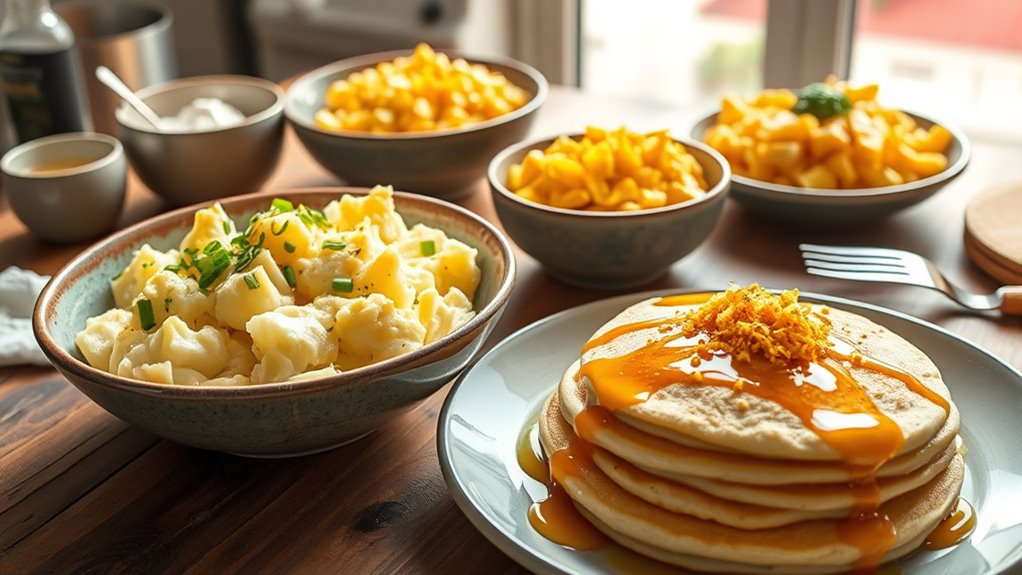
Replacing dairy and eggs with plant-based alternatives is essential when making traditional comfort foods vegan. For dairy-free desserts, you can swap out milk with almond, soy, or oat milk, which add creaminess without animal products. Coconut cream works well for richer textures, especially in pies or mousses. When it comes to eggs, egg replacer techniques like using flaxseed or chia seeds mixed with water create binding and moisture, mimicking the role of eggs in baked goods. Commercial egg replacers are also convenient for cakes and muffins. These substitutions guarantee your dishes maintain their classic textures and flavors while keeping them entirely plant-based. Incorporating color fidelity in your recipes ensures that the vibrant hues of your dishes remain appealing, even without traditional ingredients. With a little experimentation, you’ll master dairy-free desserts and egg replacer techniques that make your comfort foods just as delicious as the originals.
Using Flavorful Seasonings to Enhance Vegan Comfort Foods
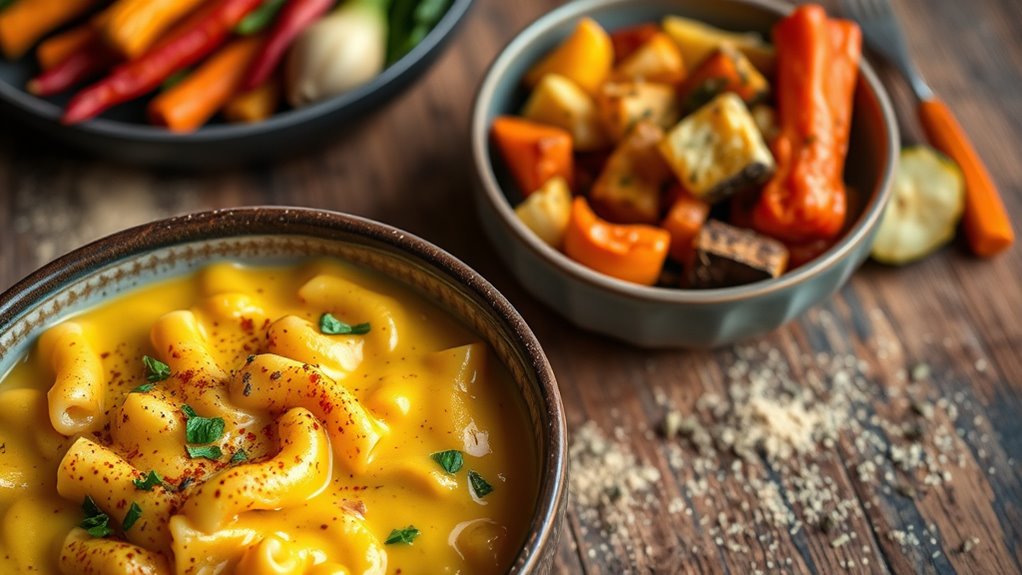
To elevate vegan comfort foods and make them truly satisfying, incorporating the right seasonings is essential. Herb blends can add depth and freshness, turning simple dishes into flavorful masterpieces. Mix herbs like thyme, rosemary, and basil to mimic traditional savory notes. Spice layering is also key; start with foundational spices such as garlic powder, onion powder, and paprika, then build complexity with cumin, smoked paprika, or chili powder. By layering spices gradually, you create a rich, balanced flavor profile that mimics the depth found in their non-vegan counterparts. Additionally, understanding the importance of shifting gears smoothly when preparing complex recipes can help you better control the cooking process and enhance flavors. Don’t be afraid to experiment with different combinations to find what best suits each dish. Using a thoughtful blend of herbs and spices will guarantee your vegan comfort foods are bursting with flavor and incredibly satisfying. Embracing curiosity in experimenting with new seasonings can also lead to delightful discoveries that enhance your culinary repertoire.
Substituting Meat With Vegetables, Legumes, and Plant Proteins
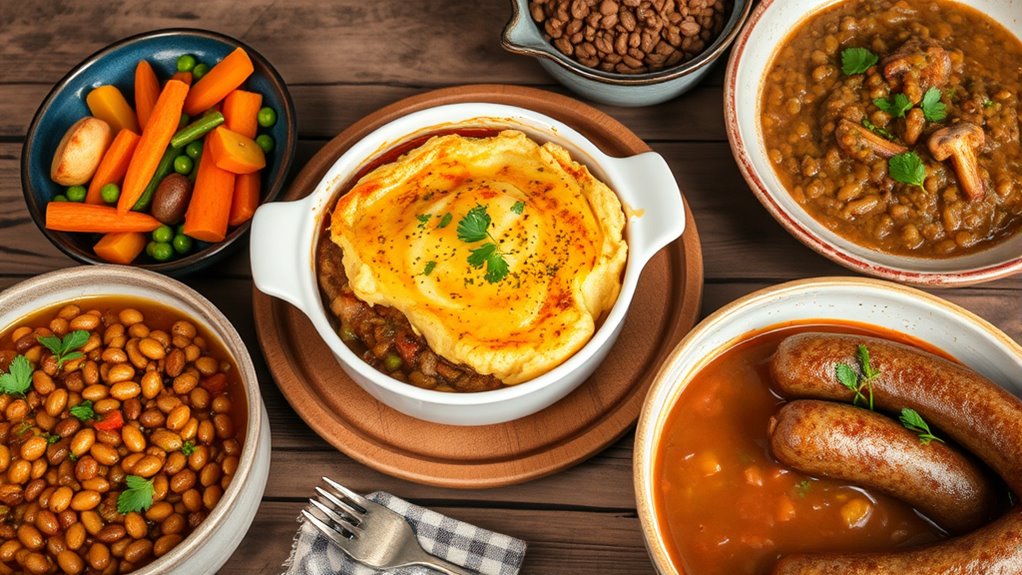
When crafting vegan comfort foods, you can transform traditional meat dishes by using vegetables, legumes, and plant-based proteins that deliver both flavor and texture. Meat replacement techniques involve choosing the right plant protein varieties to mimic the richness and chewiness of meat. Consider these options:
- Legumes like lentils and chickpeas, which work well in stews and fillings.
- Tofu and tempeh, versatile for stir-fries and sautés due to their ability to absorb flavors.
- Seitan and textured vegetable protein (TVP), which mimic the density and bite of meat in hearty dishes.
- Incorporating natural materials such as wood and stone can enhance the presentation and authenticity of vegan comfort food dishes when served in rustic-style settings. Additionally, understanding meat replacement techniques can help in achieving a satisfying texture that closely resembles traditional meat dishes.
Mastering the Art of Vegan Sauces and Gravy
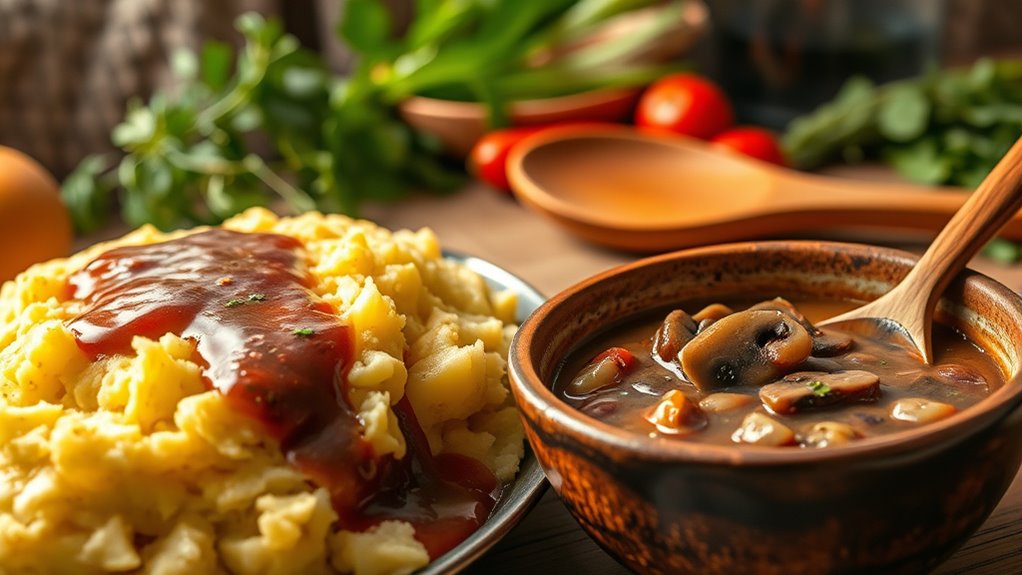
Vegetables, legumes, and plant-based proteins form the backbone of hearty vegan dishes, but finishing them with rich, flavorful sauces and gravy elevates the comfort food experience. Mastering sauce thickening techniques is essential, so you can create velvety gravies without dairy. Use ingredients like cornstarch, arrowroot, or flour to achieve the desired consistency. When experimenting with gravy recipes, taste and adjust seasonings to enhance depth and richness. Plant-based broth combined with sautéed aromatics forms a savory base, while adding nutritional yeast or miso can boost umami flavor. Remember, the key is balancing thickness with flavor, ensuring your vegan sauces complement and elevate your main ingredients. Incorporating sauce thickening techniques is crucial for achieving the perfect texture and consistency. Utilizing the right thickening agents can make all the difference in creating a smooth, luscious gravy. With practice, you’ll craft luscious, satisfying sauces and gravies that rival traditional versions.
Tips for Achieving the Perfect Texture and Creaminess
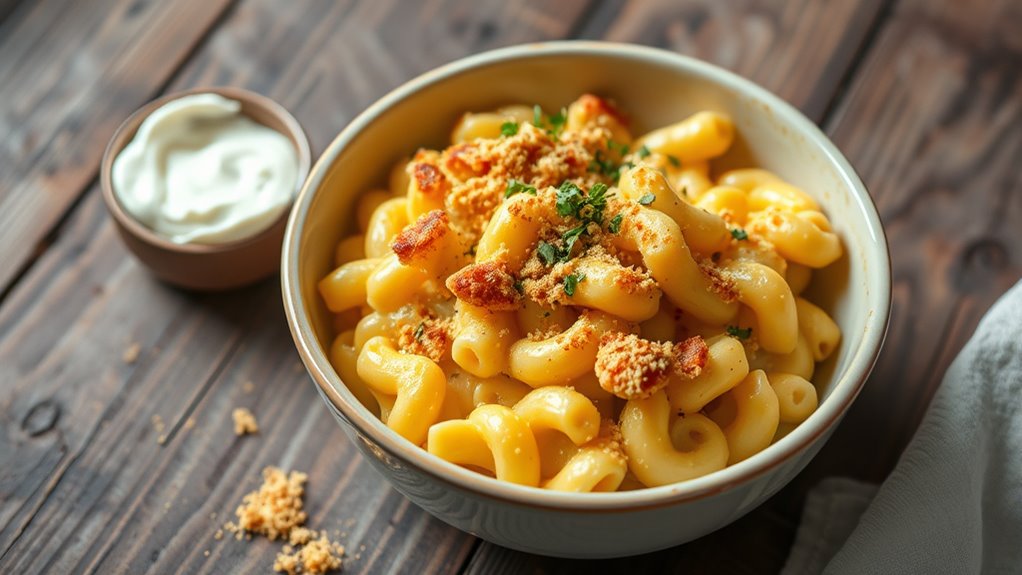
Achieving the perfect texture and creaminess in vegan dishes requires attention to detail and the right techniques. First, choose quality dairy-free cheeses that melt well and add smoothness. Second, experiment with egg replacer options like flaxseed or applesauce to help bind ingredients and create a richer, creamier consistency. Third, incorporate thickening agents such as cashew cream or coconut milk to enhance velvety textures. These methods work together to make your dishes as satisfying and luscious as their traditional counterparts. Additionally, understanding the local building codes and permits associated with renovation scope can inspire confidence and ensure compliance in your culinary projects. Ensuring proper kitchen safety standards can also help prevent mishaps during food preparation. Incorporating mindfulness practices into your cooking routine can enhance focus and elevate your culinary creations. Paying attention to ingredient quality is crucial for achieving the desired texture and flavor. Always taste and adjust as you go, ensuring the balance of creaminess and texture. Additionally, understanding the aura colors associated with emotional states can inspire creativity and balance in your cooking process. With these tips, you’ll master the art of creating vegan comfort foods that are both delicious and perfectly textured.
Frequently Asked Questions
Can Vegan Comfort Foods Be as Filling as Traditional Versions?
You might wonder if vegan comfort foods can be as filling as traditional ones. The answer is yes, especially when you use hearty meat alternatives and create creamy textures with plant-based ingredients like cashew cream or coconut milk. These options add richness and satiety, making your vegan dishes just as satisfying. With the right ingredients and preparation, you can enjoy comforting meals that fuel you just as well as classic versions.
What Are Common Pitfalls When Veganizing Classic Recipes?
When veganizing classic recipes, you might stumble over ingredient substitutions that don’t quite mimic the original texture or flavor. It’s easy to overlook flavor balancing, which can leave your dish flat or off-putting. To avoid these pitfalls, experiment with seasonings and alternative ingredients, tasting as you go. This guarantees your vegan comfort food remains satisfying and true to the comforting essence of the traditional version.
How Do I Adjust Cooking Times for Plant-Based Ingredients?
Adjusting cooking times for plant-based ingredients is like tuning a musical instrument—you need to pay attention. You’ll want to monitor cooking temperature carefully, as vegan ingredients often cook faster or slower than their traditional counterparts. When ingredient substitution is involved, expect slight variations in texture and doneness. Keep an eye on your dish, and don’t be afraid to test for doneness frequently to guarantee perfect results.
Are There Any Allergen Concerns With Vegan Substitutes?
When using vegan substitutes, you should be aware of potential allergen concerns. For example, if you have dairy allergies, look for dairy-free options like plant-based milks and cheeses. If you have soy sensitivities, avoid soy-based products such as tofu and soy milk. Always check labels carefully, as some substitutes may contain allergens. Choosing allergen-friendly options guarantees you enjoy your vegan comfort foods safely and comfortably.
How Can I Ensure My Vegan Comfort Foods Are Budget-Friendly?
Imagine sinking into a warm, comforting dish without breaking the bank. To keep your vegan comfort foods budget-friendly, focus on cost-effective ingredients like beans, rice, and seasonal vegetables. Use smart meal planning strategies to minimize waste and maximize flavor. Shop sales, buy in bulk, and choose versatile ingredients that can serve multiple recipes. With these simple tips, you can indulge in hearty vegan meals without overspending.
Conclusion
Transforming traditional comfort foods into vegan delights is like turning a familiar song into a new melody—still comforting, but with a fresh twist. By swapping dairy, eggs, and meat for plant-based ingredients, you create a symphony of flavors that satisfy your cravings and nourish your body. Embrace these techniques, and you’ll craft hearty, cozy dishes that feel like a warm hug—only now, they’re kinder to animals, the planet, and your health.
Hi, I’m Alexander. I’m a vegan of over 20 years, and I initially made the switch for health reasons. However, as time went on, I became more and more passionate about the ethical and environmental implications of leading a vegan lifestyle.
I am the author of The Graceful Kitchen, a vegan blog where I share recipes for delicious and nutritious vegan meals. As someone who is deeply committed to living a cruelty-free life, I am also a strong advocate for using whole foods as the foundation of a healthy diet – and believe that going vegan is one of the best ways to achieve this.
